Cirsium neomexicanum, New Mexico Thistle
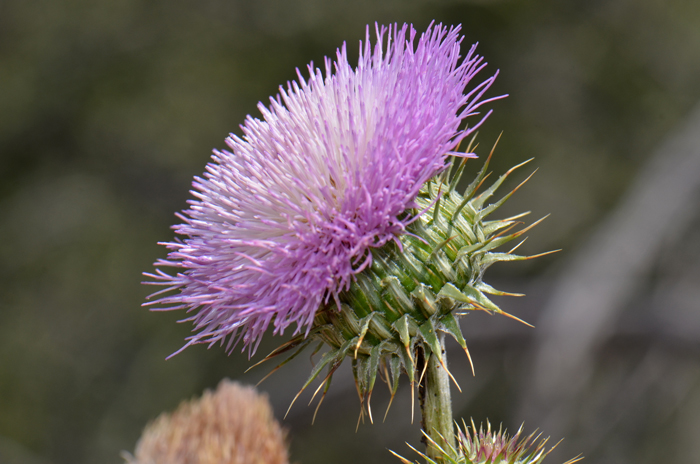
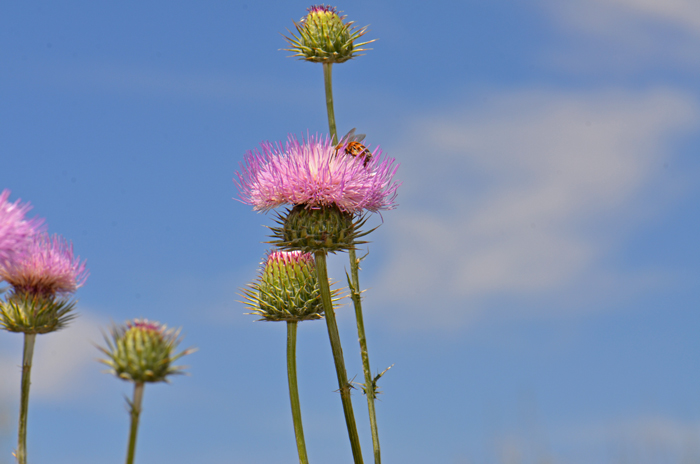
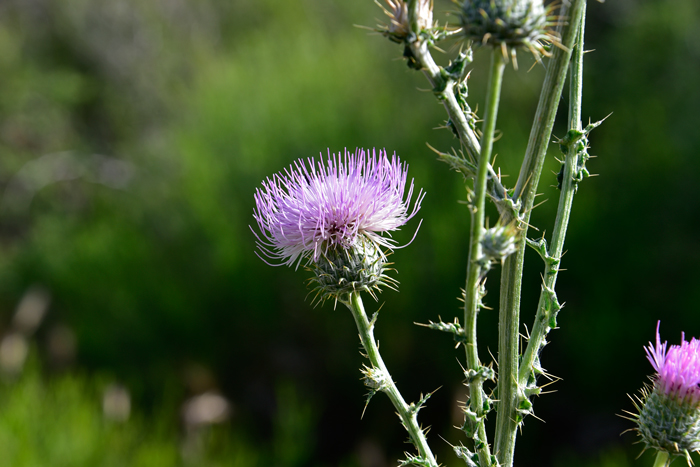
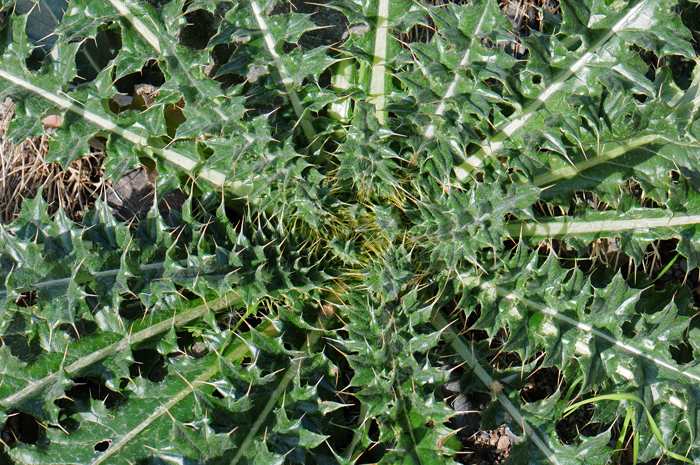
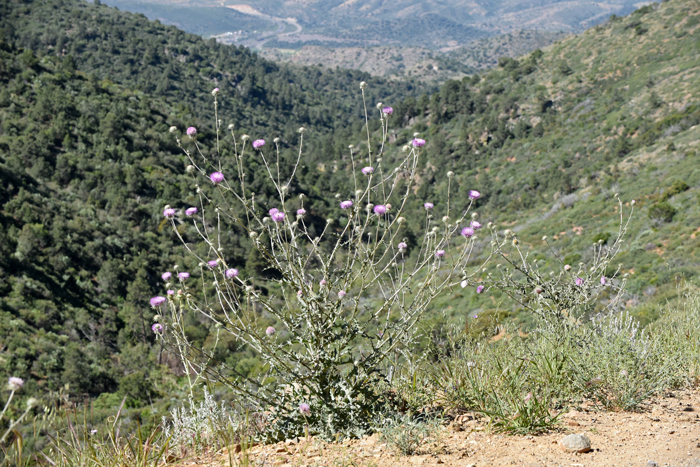
Scientific Name: Cirsium neomexicanum
Common Name: New Mexico Thistle
Also Called: Desert Thistle, Foss Thistle, Lavender Thistle, Powderpuff Thistle, Utah Thistle (Spanish: Cardo Santo)
Family: Asteraceae, Sunflower Family
Synonyms: (Carduus inamoenus, Cirsium arcuum, Cirsium neomexicanum var. neomexicanum, Cirsium neomexicanum var. utahense, Carduus nevadensis, Cirsium humboldtense, Cirsium utahense, Cirsium wallowense)
Status: Native
Duration: Biennial or short lived perennial.
Size: Up to 6 feet (3 m) or more in height.
Growth Form: Forb/herb; erect, main stem, some branching above, spotted with cobweb (arachnoid) like patches of short soft hairs; all parts with long stiff sharp spines.
Leaves: Green or greenish-gray; highly variable along stems; basal rosettes, upper oblong-elliptic to oblanceolate, deeply pinnatifid, uppermost leaves shorter, wing like bracts; spiny throughout.
Flower Color: Pink or purple, lavender or white; disk flowers only, large showy flower heads 2 or 3 inches (5-7.6 cm) wide, surrounded by sharp spine tipped bracts or phyllaries; solitary or 2 or 3 flower heads on tips of peduncles, loose corymb-like arrays.
Flowering Season: March to September, successful blooms following winter and spring rains and again after heavy summer monsoon rainfall.
Elevation: 1,000 to 6,500 feet (300-2,000 m).
Habitat Preferences: Plains, mesas, rocky hillsides, canyons, foothills, roadsides, washes, dry exposed slopes; multiply habitat types; generally dry grasslands, arid pinyon woodlands, junipers, oaks and Joshua trees.
Recorded Range: In the United States in AZ, CA, CO, NM, NV and UT and in northwest Mexico. New Mexico Thistle is scattered throughout most of Arizona.
North America & US County Distribution Map for Cirsium neomexicanum.
North America species range map for Cirsium neomexicanum:
North American range map courtesy of Virginia Tech, Dept. of Forest Resources & Environmental Conservation
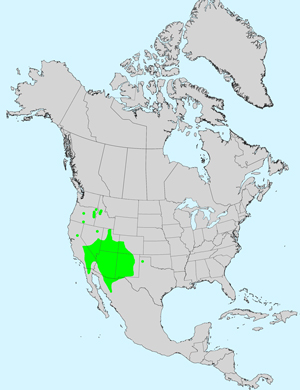
U.S. Weed Information: Unknown
Invasive/Noxious Weed Information: In North America the genus Cirsium is listed as a Noxious Weed by the States of:
Plants included here are invasive or noxious. See the Comments: section below for additional information regarding “noxious” thistles.
Wetland Indicator: Unknown
Threatened/Endangered Information: Unknown Genus Information: In North America there are 91 species for Cirsium. Worldwide, The Plant List includes 481 accepted species names and a further 812 scientific names of infraspecific rank for the genus. The genus Cirsium was published by Philip Miller in 1754.
In the Southwestern United States: Arizona and New Mexico each have 19 species of genus, California has 27 species, Nevada has 16 species, Texas has 12 species, Utah has 23 species. All data approximate and subject to revision.
Comments: A southwestern species, the geographic range of New Mexico Thistle suggests it to be a Mojave Desert species although it is native to and common in both the Mojave and Sonoran Deserts. In addition to the comments below, many insect species feed on New Mexico thistle.
The genus Cirsium in general, has received adverse notoriety because of the introduction of two thistles native to Europe and now widespread throughout North America. The Canadian Thistle, Cirsium arvense and and the Bull Thistle, Cirsium vulgare are both listed as noxious primarily by agricultural interests. The Canadian Thistle and Bull Thistle together for example are listed as noxious weeds in 33 and 9 states respectively.In reality, most southwestern native thistles, including Graham's Thistle, are non-aggressive; non-invasive and beneficial as pollinators. Our native thistles have evolved over thousands of years and have mostly thrived without ever becoming weedy. However, many native thistles are now threatened and some species are at risk of extinction.
For a comprehensive thoroughly documented review of New Mexico Thistle see the USDA USFS Fire Effects Information System, or FEIS.
In Southwest Desert Flora also see; Arizona Thistle, Cirsium arizonicum, Graham's Thistle Cirsium grahamii Mohave Thistle, Cirsium mohavense and Yellowspine Thistle, Cirsium ochrocentrum.
For an interesting article on native thistles in North America see Native Thistles: A Conservation Practitioner's Guide, published on-line by The Xerces Society, For Invertebrate Conservation.
The species epithet neomexicanum is a direct reference meaning of or from or otherwise honoring New Mexico.
New Mexico Thistle has been used for medicinal purposes by Navajo and Yavapai Indians.
See species account from Native American Ethnobotany, University of Michigan, Dearborn.

